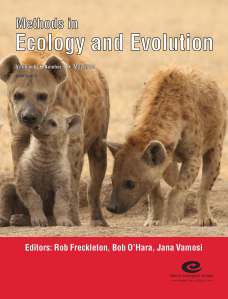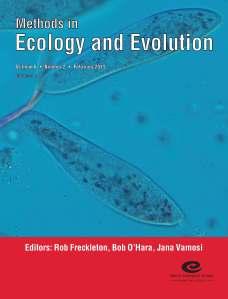Happy National Wildlife Day everyone!
Today is 10th National Wildlife Day. As we have done for a few awareness days this year (Bats, Biodiversity and Bees so far) we are marking the day by highlighting some of our favourite Methods in Ecology and Evolution articles on the subject. Obviously ‘wildlife’ is a pretty big topic, so we have narrowed our focus (slightly) to monitoring wildlife (with one or two additional papers that we didn’t want to leave out).
This list is certainly not exhaustive and there are many more wonderful articles on these topics in the journal. You can see more of them on the Wiley Online Library.
If you would like to learn more about National Wildlife Day, you may wish to visit the organisation’s website, follow them on Twitter and Facebook or check out today’s hashtag: #NationalWildlifeDay.
Without further ado though, please enjoy our selection of Methods articles for National Wildlife Day:
 Integrating Demographic Data
Integrating Demographic Data
Our National Wildlife Day celebration begins with an article from our EURING Special Feature. Robert Robinson et al. present an approach which allows important demographic parameters to be identified, even if they are not measured directly, in ‘Integrating demographic data: towards a framework for monitoring wildlife populations at large spatial scales‘. Using their approach they were able to retrieve known demographic signals both within and across species and identify the demographic causes of population decline in Song Thrush and Lawping.
 Population Monitoring
Population Monitoring
Our second article comes from the June 2015 issue of the journal. In this Application article (which is freely available to all), Martha Ellis and her colleagues present rSPACE: an open-source R package for implementing a spatially based power analysis for designing monitoring programs. rSPACE parameterizes a spatially explicit population simulation by incorporating information on species biology and habitat. The authors demonstrate their method and software with an analysis of Wolverine monitoring.
 Acoustic Monitoring
Acoustic Monitoring
The oldest paper that we are highlighting today comes from the December 2012 issue of the journal. As it is over two years old, this paper is also freely available. In ‘Do you hear what I hear? Implications of detector selection for acoustic monitoring of bats‘ Amanda Adams et al. compare the detection of echolocation calls among five commonly used bat detectors. They conclude that it is important to take the choice of detector into account in designing studies and considering bat activity levels among studies using different detectors.
 Field Surveys Vs Remote Sensing
Field Surveys Vs Remote Sensing
Next up is the most recent article that we are highlighting today. In the July 2015 issue of the journal we published Christopher Rhodes et al.’s article ‘The relative value of field survey and remote sensing for biodiversity assessment‘. In this paper, the authors compare high-resolution sample-based field survey (Countryside Survey) with medium-resolution remotely sensed habitat data (a high resolution of Land Cover Map). They conclude that for the best results remote sensing and field survey data should be combined (as did Nathalie Pettorelli in her blog post and her Methods 5th Anniversary talk).
 Measuring Diversity
Measuring Diversity
Novel algorithms have been recently developed to estimate alpha and partition beta diversity in all their dimensions. In an Applications article (so, again, freely available to everyone), Pedro Cardoso et al. introduce the R Package BAT (Biodiversity Assessment Tools). This package performs a number of analyses based on either species identities or trees depicting species relationships. The authors include several examples to demonstrate the utility of their method.
 Camera Monitoring
Camera Monitoring
In our penultimate National Wildlife Day article, ‘A high-resolution panorama camera system for monitoring colony-wide seabird nesting behaviour‘, Tim Lynch et al. describe the application of a robotic camera system. This system, Gigapan, provides the spatial advantages of aerial photos with the detail and temporal replication of land-based camera systems. It can an extend or enhance traditional data collection methods, particularly for simultaneous observations at distance, of the behaviour of surface nesting colonial seabirds.
 Inferring Extinction
Inferring Extinction
As one of the main goals of National Wildlife Day is to protect species that are endangered, we decided to end our celebration of the day with Tamsin Lee’s article ‘A simple numerical tool to infer whether a species is extinct‘. Including uncertain sightings when inferring extinction of a species is relatively new and has proven to be significant, but can lead to mathematical problems. Using a Bayesian model which includes uncertainty around the prior, uncertain sightings and survey effort, the author is able to infer extinction from a sighting record.
We hope that you have a great National Wildlife Day!

One thought on “National Wildlife Day 2015”